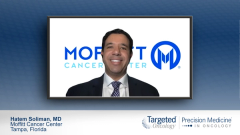
Prognostic Tools for Early Stage BC
A discussion on the importance of prognostic tools for early stage breast cancer.
Episodes in this series

Hatem Soliman, MD: In keeping with the biomarker story, one of the topics that was clinically relevant was looking at the development and validation of prognostic tools for early breast cancer. This particular presentation wasn’t specifically targeted toward ascertaining some sort of prognostic signature in HER2-positive patients, but it does demonstrate a key principle.
It’s worth mentioning, because it applies across subtypes, too, the presentation by [Joseph] Sparano, [MD,] regarding the development of the RSClin tool, which is a tool on the Genomic Health website for a number of years. This tool is used to try to marry the clinical presentation of the patient and their stage, and some of the tumor phenotypes that we see, particularly size and grade, along with the recurrence score, information that we get from the Oncotype DX report, to give us a more accurate prognostication of the patient’s specific case. This is most helpful when dealing with tumors particularly on extremes of the scale, where there are very small tumors or very large tumors. Sometimes, when talking about the report by itself, divorced from those parameters, you tend to get a sense of underestimation or overestimation of actual risk, compared to what’s sitting in front of you. [Dr Sparano] took the calculator that was incorporating the recurrence score, alongside the hormonal treatment that was proposed for the patient, either tamoxifen or aromatase inhibitor, the age of the patient, the size of the tumor, and the grade of the tumor as well, and by plugging those parameters into the calculator, you’re able to get a more precise prognostic prediction for a patient, by taking both the recurrence score and genomic data along with clinical parameters.
Andrew Seidman, MD: I’ve used the calculator, the RSPC [recurrence score pathology-clinical], and Gong Tang, [PhD,] was one of the original developers. It has been on the website online.genomichealth.com, and it can open up your eyes for patients who have those smaller T1B tumors or those larger T2 tumors, approaching T3, and these are all node-negative. From TAILORx, the group that a lot of doctors struggle with are those less than age 50, often premenopausal patients with node-negative disease, with that recurrence score in that 16 to 25, or even perhaps more likely, 21 to 25 range, where is appears there could be some possible chemotherapy benefit. Some of it might be related to ovarian failure from chemotherapy. But here, tumor size, grade, and age can give you a more refined estimate of that patient’s risk of recurrence than your simple Oncotype report and might help inform the discussion with the patient.
Hatem Soliman, MD: It’s important to emphasize that when talking about these prognostic tools, there are a variety of these calculators and ideas out there for trying to integrate all the clinical information that we see to get an accurate assessment of what that patient’s risk is. Then trying to tailor treatment that’s appropriate for that risk, so we’re not undertreating or overtreating patients, and we’re trying to give them what they need, to assure them of the best odds of cure, with the least amount of morbidity and toxicity associated. This is done to an extent with early stage HER2+ disease, when looking at the stage that’s being presented to us and making decisions about escalating or de-escalating therapy on that basis, too.
Andrew Seidman, MD: The biggest decision about escalation is simply the decision to give chemotherapy, yes or no, not to give third-generation therapy with dose-dense AC [doxorubicin, cyclophosphamide], paclitaxel, or TC [docetaxel, cyclophosphamide], or even CMF [cyclophosphamide, methotrexate, fluorouracil].
Transcript edited for clarity.













































